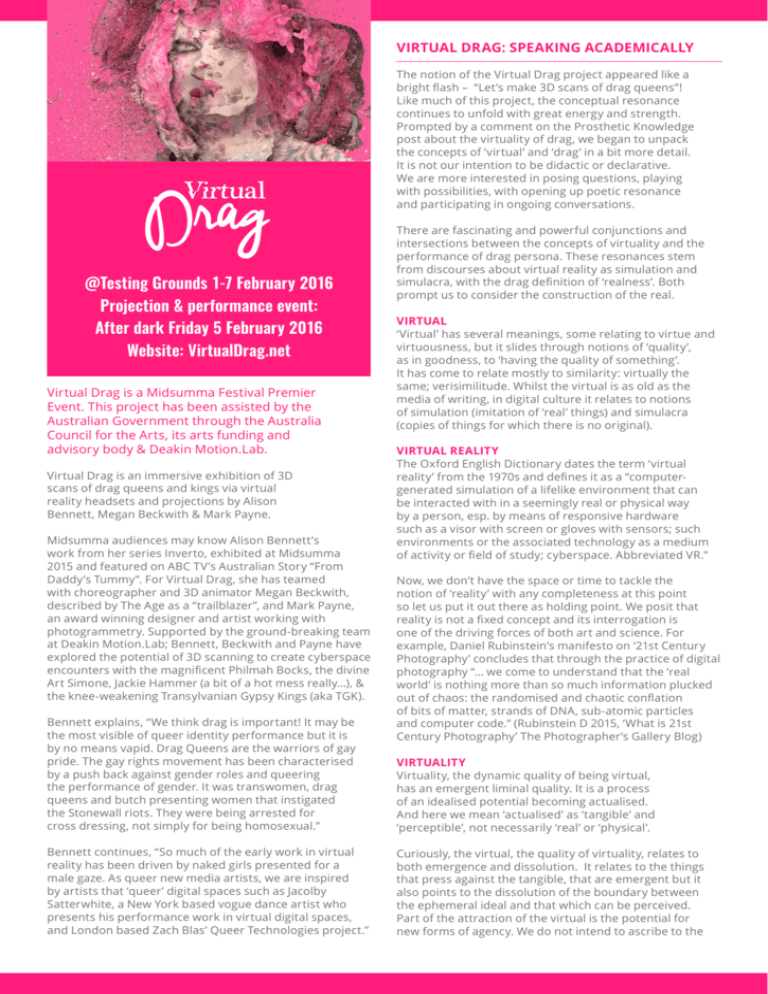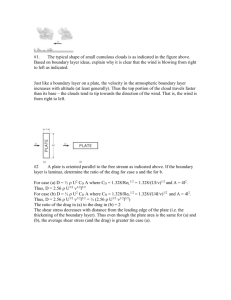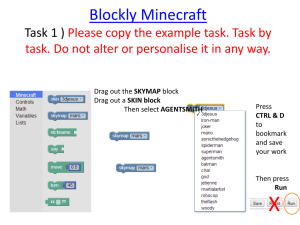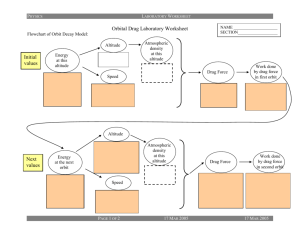pdf of essay - Virtual Drag!
advertisement

VIRTUAL DRAG: SPEAKING ACADEMICALLY The notion of the Virtual Drag project appeared like a bright flash – “Let’s make 3D scans of drag queens”! Like much of this project, the conceptual resonance continues to unfold with great energy and strength. Prompted by a comment on the Prosthetic Knowledge post about the virtuality of drag, we began to unpack the concepts of ‘virtual’ and ‘drag’ in a bit more detail. It is not our intention to be didactic or declarative. We are more interested in posing questions, playing with possibilities, with opening up poetic resonance and participating in ongoing conversations. @Testing Grounds 1-7 February 2016 Projection & performance event: After dark Friday 5 February 2016 Website: VirtualDrag.net Virtual Drag is a Midsumma Festival Premier Event. This project has been assisted by the Australian Government through the Australia Council for the Arts, its arts funding and advisory body & Deakin Motion.Lab. Virtual Drag is an immersive exhibition of 3D scans of drag queens and kings via virtual reality headsets and projections by Alison Bennett, Megan Beckwith & Mark Payne. Midsumma audiences may know Alison Bennett’s work from her series Inverto, exhibited at Midsumma 2015 and featured on ABC TV’s Australian Story “From Daddy’s Tummy”. For Virtual Drag, she has teamed with choreographer and 3D animator Megan Beckwith, described by The Age as a “trailblazer”, and Mark Payne, an award winning designer and artist working with photogrammetry. Supported by the ground-breaking team at Deakin Motion.Lab; Bennett, Beckwith and Payne have explored the potential of 3D scanning to create cyberspace encounters with the magnificent Philmah Bocks, the divine Art Simone, Jackie Hammer (a bit of a hot mess really…), & the knee-weakening Transylvanian Gypsy Kings (aka TGK). Bennett explains, “We think drag is important! It may be the most visible of queer identity performance but it is by no means vapid. Drag Queens are the warriors of gay pride. The gay rights movement has been characterised by a push back against gender roles and queering the performance of gender. It was transwomen, drag queens and butch presenting women that instigated the Stonewall riots. They were being arrested for cross dressing, not simply for being homosexual.” Bennett continues, “So much of the early work in virtual reality has been driven by naked girls presented for a male gaze. As queer new media artists, we are inspired by artists that ‘queer’ digital spaces such as Jacolby Satterwhite, a New York based vogue dance artist who presents his performance work in virtual digital spaces, and London based Zach Blas’ Queer Technologies project.” There are fascinating and powerful conjunctions and intersections between the concepts of virtuality and the performance of drag persona. These resonances stem from discourses about virtual reality as simulation and simulacra, with the drag definition of ‘realness’. Both prompt us to consider the construction of the real. VIRTUAL ‘Virtual’ has several meanings, some relating to virtue and virtuousness, but it slides through notions of ‘quality’, as in goodness, to ‘having the quality of something’. It has come to relate mostly to similarity: virtually the same; verisimilitude. Whilst the virtual is as old as the media of writing, in digital culture it relates to notions of simulation (imitation of ‘real’ things) and simulacra (copies of things for which there is no original). VIRTUAL REALITY The Oxford English Dictionary dates the term ‘virtual reality’ from the 1970s and defines it as a “computergenerated simulation of a lifelike environment that can be interacted with in a seemingly real or physical way by a person, esp. by means of responsive hardware such as a visor with screen or gloves with sensors; such environments or the associated technology as a medium of activity or field of study; cyberspace. Abbreviated VR.” Now, we don’t have the space or time to tackle the notion of ‘reality’ with any completeness at this point so let us put it out there as holding point. We posit that reality is not a fixed concept and its interrogation is one of the driving forces of both art and science. For example, Daniel Rubinstein’s manifesto on ‘21st Century Photography’ concludes that through the practice of digital photography “… we come to understand that the ‘real world’ is nothing more than so much information plucked out of chaos: the randomised and chaotic conflation of bits of matter, strands of DNA, sub-atomic particles and computer code.” (Rubinstein D 2015, ‘What is 21st Century Photography’ The Photographer’s Gallery Blog) VIRTUALITY Virtuality, the dynamic quality of being virtual, has an emergent liminal quality. It is a process of an idealised potential becoming actualised. And here we mean ‘actualised’ as ‘tangible’ and ‘perceptible’, not necessarily ‘real’ or ‘physical’. Curiously, the virtual, the quality of virtuality, relates to both emergence and dissolution. It relates to the things that press against the tangible, that are emergent but it also points to the dissolution of the boundary between the ephemeral ideal and that which can be perceived. Part of the attraction of the virtual is the potential for new forms of agency. We do not intend to ascribe to the utopian hype of VR but the virtual is inherently idealistic regardless of the media through which it is manifest. “The virtual in this sense is nothing new; its associations with the ultramodern, the digital and life abstracted from the material real are only the present guise of something much older. The virtual is as old as writing itself; it is nothing new, but it drives the new; it is that which compels the generation of thought.” (Johnson A 2010, ‘Nomad Words’ in Pollock, G, & Bryant, A 2010, Digital and Other Virtualities : Renegotiating the Image, I.B.Tauris, London) Goodrich points to “Baudrillard’s notion of the collapse of the distinction between the real and the virtual… for Baudrillard, the virtual does not indicate a difference across orders, but indeed the complete collapse of orders, so that the real and the virtual become indistinguishable (on an ontological level). For Baudrillard, images have lost their ability to be virtual because a real referent can no longer be distinguished – what once was designated as virtual is now more present than reality itself (or reality is so imbricated with these images that the difference becomes moot). Against virtuality, Baudrillard posits the hyper-real.” (Goodrich A 2002, ‘Virtuality’ in University of Chicago Theories of Media Keywords Glossary) This collapse might also be seen in the emergence of the posthuman cyborg as a cultural entity, of the collapse of the categories of ‘human’ / ‘technological’ / ‘natural’. What might the concept of virtuality reveal when applied to the practice of drag culture? What could drag reveal about the emergence of virtual cultural practices? What is the virtuality of drag? What might the drag concept of ‘realness’ reveal about the structures that constitute virtual reality. ‘REALNESS’ In Jennie Livingston’s documentary Paris is Burning on the 1980s New York Drag Ballroom scene, Dorian Corey discusses the concept of ‘realness’: “In a ballroom, you can be anything you want. You’re not really an executive, but you’re looking like an executive. And therefore, you’re showing the straight world that, ‘I can be an executive. If I had the opportunity, I can be one. Because I can look it.’ And that is a kind of fulfilment. Your friends, your peers, are telling you, ‘Oh, you’d make a wonderful executive’.” Queer theorist Tim Dean expands: “For the characters in Paris is Burning realness is the ultimate accolade, since this term denotes the degree of successful imitation produced by a gender performance. As an effect of scrupulously accurate mimesis, realness is in some sense the social or subcultural equivalent of the aesthetic category of realism. Literary critics such as Roland Barthes have argued for the concept of a “reality effect” as undercutting the aesthetic of realism by showing how prerepresentational reality – to whose faithful imitation the transparency of realist representation aspires – is itself the effect of highly complex and artificial rhetorical codes. Similarly, gender critics such as Butler argue that drag realness undermines the ontological or existential status of every identity, especially gender identity, by showing the imitative and fictive structure of identity – and thence of everything reality. Realness reveals social reality as a construct, something fabricated? (Dean T 2000, Beyond Sexuality, University of Chicago Press, Chicago) Drag ‘realness’ resonates with virtuality, the manifestation of the constructed and contingent frameworks of culture and identity, the liminal transit/vector between ideal and tangible. It is both superficial and core. Which is fabulous! DRAG As usual, gender theorist Judith Butler wipes the floor with her fierce insight. In the passage below from her 1990 essay “Imitation and Gender Insubordination” Butler argues there is no original gender expression. She positions gender as simulacra, a copy of a copy. Heterosexual gender is also performative but seeks to position itself as ‘original’. The performance of drag reveals these structures. Now, we are not saying that gender expression is inauthentic, arbitrary or fake. Butler’s point is that gender is performative, virtual as both emergence and dissolution, that it is manifest through reenactment and reproduction. Indeed, gender expression is a process, a transition, a becoming. What we are saying is that gender does not have a ‘proper’ expression but that gender expression does not have belong exclusively to any particular group or classification. “Drag is not the putting on of a gender that belongs properly to some other group, i.e. an act of expropriation or appropriation that assumes that gender is the rightful property of sex, that “masculine” belongs to “male” and “feminine” belongs to “female”. There is no “proper” gender, a gender proper to one sex rather than on other, which is in some sense that sex’s cultural property. Where the notion of the “proper” operates, it is always and only improperly installed as the effect of a compulsory system. Drag constitutes the mundane way in which genders are appropriated, theatricalized, worn, and done; it implies that all gendering is a kind of impersonation and approximation. If this is true, it seems, there is no original or primary gender that drag imitates, but gender is a kind of imitation that produces the very notion of the original as an effect and consequence of the imitation itself.” (Butler J 1990, “Imitation and Gender Insubordination” in Seidman S & Alexander J 2001, The New Social Theory Reader: Contemporary Debates, Routledge NY) IN CONCLUSION As we said at the top, we are not seeking to make didactic statements about the Virtual Drag project. Our purpose here is to articulate starting points and foundations. This creative project is a means of investigating these ideas, not a means of presenting already resolved positions. Indeed, we make work as a means of posing questions because we have yet to grasp something. Through the process of making and exhibiting this work, we are exploring the potentials of the relationship between ‘drag’ and ‘virtual’. Not only is this an opportunity to ask how virtuality might reflect upon gender but, perhaps even more interestingly, how might the notion of ‘realness’ and the practice of drag performance offer fresh perspectives on the cultural production of virtual reality. Drag is not a simulation or appropriation of an original and proper gender but a joyful critique and celebration, a copy of a copy of a copy, a knowing wink, a profoundly queer insertion in the complex theatre and becoming of identity. Alison Bennett, December 2015 www.VirtualDrag.net









